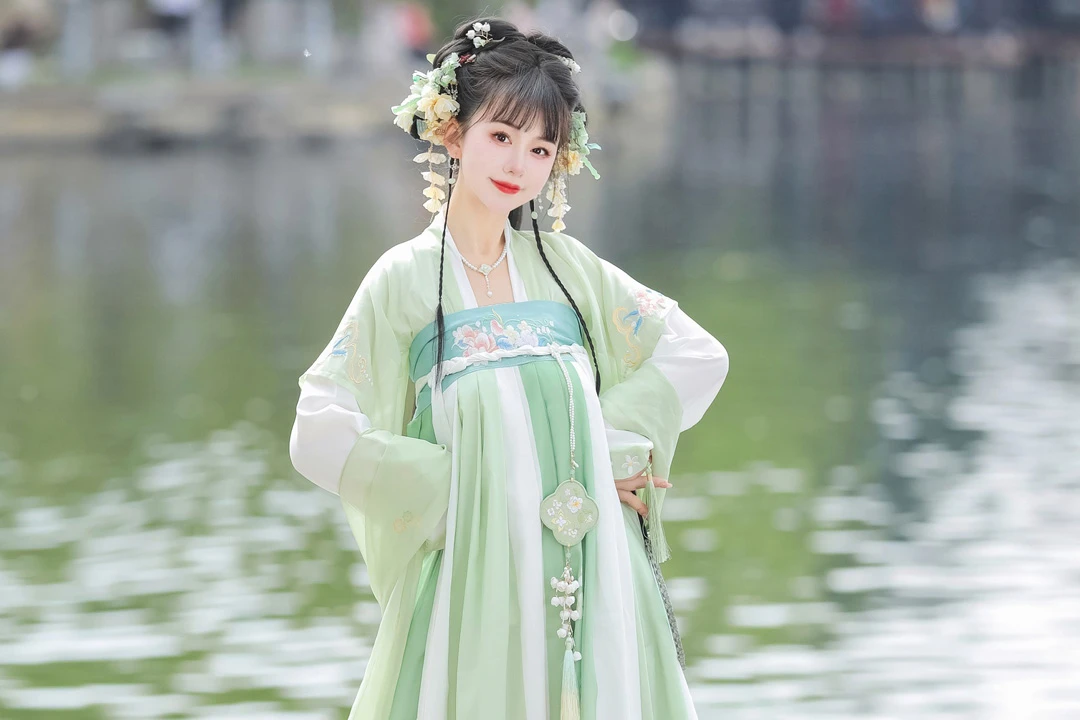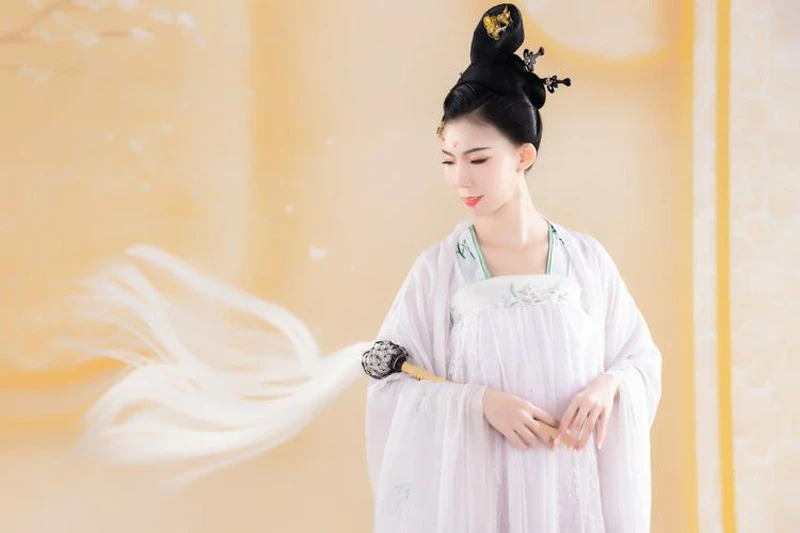Hanfu, the traditional clothing of the Han Chinese people, is making a comeback in modern China. While the whole hanfu ensemble is visually striking, one element in particular stands out – the flowing, voluminous sleeves. Long, loose sleeves have been a hallmark feature of hanfu throughout history, serving both aesthetic and functional purposes. Here we’ll take a closer look at the origins and appeal of the big, billowing hanfu sleeve.
Long sleeve hanfu garments first emerged in China as early as the Shang Dynasty, as evidenced by archaeological finds. During the Zhou Dynasty, the wide, loose sleeves we now associate with hanfu began to take shape. The ample sleeves allowed greater ease of movement and airflow, suiting the Zhou lifestyle which centered around hunting and battle.
The long sleeves became even more exaggerated during the Han Dynasty, sometimes extending well past the wearer’s fingertips. Swathes of fabric would sway and dance with the movements of the arm, creating a mesmerizing effect. There were practical reasons for the outsized sleeves too. Chinese winters could be bitterly cold, and the spacious sleeves provided insulation against the chill. The capacious sleeves also allowed items to be discretely tucked away and produced with a flick of the wrist, useful for scholars and officials who wanted easy access to supplies like brushes and paper.
Though the sleeves shortened slightly during the Tang Dynasty, they remained an eye-catching focal point of Tang fashion. For women, beautiful brocade sleeves swayed enticingly on the dance floor and trailed through the streets like the train of a gown. Paintings from the era captured the striking image of a woman demurely raising a single delicate hand to show just a glimpse of a richly embroidered sleeve.
The vibrantly colored and patterned sleeves seen in Tang art evolved into the elegant monochrome sleeves of the Song Dynasty. Often made of light, gauzy silk, these offered a refined counterpoint to the simple, clean lines of Song clothing. Scholar-officials would allow the long pendent sleeve to add a touch of gravitas to their reserved gray robes.
Over the centuries, Chinese sleeves continued to flow through cycles of exaggeration and restraint. But whether ballooning or tapered, sleeves remained an integral part of fashion and an indicator of status.
In today’s hanfu revival, the most popular styles hearken back to the sleeves of the Tang and Song eras. These voluminous shapes have a romantic, antiquated allure that appeals to those seeking to connect with China’s past. From street fashionistas to models walking the runway, the flowing hanfu sleeve makes a visually arresting statement.
The sweeping sleeves have a dancerly, ethereal quality as they flutter and billow. Yet the fabric also falls with a weight and drama that conveys dignity and important. It’s this blend of grace and gravitas that makes the long hanfu sleeve such an integral part of the garment’s overall aura.
Beyond aesthetics, the ample sleeves allow for creative layering and concealment. Small items can be tucked away and revealed with a gesture, or accessories layered over the arms to add visual interest. For modern wearers, these sleeves invite playfulness and personal expression.
Hanfu with long, loose sleeves also retain the functional advantage of comfort and breathability. The roomy cut and airy fabrics make them ideal for China’s hot summers. And given their history, the flowing sleeves intrinsically feel like a natural, authentic part of the hanfu tradition.
In recent decades, changing fashion norms and Western influence had pushed the iconic billowing hanfu sleeve to the margins. But as interest in traditional culture surges among Chinese youth, so too has the popularity of the classic long sleeve. Though its origins stretch back millennia, the loose hanfu sleeve feels entirely at home in the 21st century, bringing a graceful touch of old China to the modern day.
The Allure Endures Through the Ages
As we’ve seen, the voluminous hanfu sleeve has long been an integral element of Chinese dress. Its origins were practical, but it evolved into an aesthetic statement and cultural symbol. The sleeve’s popularity has waxed and waned over the centuries, but it endures as an iconic feature of hanfu style.
Looking ahead, the billowing hanfu sleeve is poised to continue captivating new generations. Its timeless beauty and strong connection to Chinese tradition near-guarantees its survival even against fading trends and outside influences.
For traditionalists, the appeal is obvious – the generously sized, flowing sleeve represent an authentic hanfu silhouette preserved over millennia. It conjures immediate associations with China’s past and visually conveys traditional ideals like modesty and refinement.
Yet the luxe, outsized sleeve also attracts fashion-forward youth who appreciate it on an aesthetic level. Whether in sleek minimalist shapes or paired with bold patterns and colors, the voluminous sleeve manages to feel both classically elegant and modernly edgy.
Designers are also breathing new life into the sleeve by incorporating smart textiles and construction that add shape and structure. This allows the sleeve to hold its form rather than simply drape. Cleverly placed interior ties and wraps at the cuffs also permit wearers to control the sleeves’ dance and flow.
The popularity of long flowing sleeves now reaches beyond China too. International brands are integrating hanfu elements like the roomy sleeve into their designs, helping spread appreciation globally. And social media is exposing diverse audiences worldwide to images of the photogenic, dramatic Chinese sleeve.
Even entertainment and pop culture now celebrates the sleeve, from period dramas showcasing intricate imperial sleeves to modern celebrities rocking sleeve dance moves.
Yet future challenges can’t be ignored either. As labor costs rise, the intricate tailoring needed for quality loose sleeves also increases in price. Younger generations attracted to fast fashion may balk at the investment needed for well-made examples. Maintaining artisanal skills in the Internet Age is also an obstacle.
However, on the whole the future looks bright for the billowing hanfu sleeve’s longevity. Its rich cultural legacy and inherent elegance give it a competitive edge. With the flexibility to evolve with the times, the flowing Chinese sleeve is sure to remain an appealing style perennial.
From ancient court dress to 20th century school uniforms to today’s fashion runways, the oversized hanfu sleeve has always made a statement. As Chinese culture is re-embraced domestically and spreads internationally, so too will the iconic voluminous silhouette. Though the sleeve’s significance has transformed over time, its alluring spirit endures. In any form, the grand sweeping sleeve is hanfu’s most graceful calling card.


